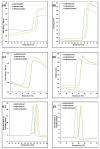Interaction Mode of the Novel Monobactam AIC499 Targeting Penicillin Binding Protein 3 of Gram-Negative Bacteria
- PMID: 34356681
- PMCID: PMC8301747
- DOI: 10.3390/biom11071057
Interaction Mode of the Novel Monobactam AIC499 Targeting Penicillin Binding Protein 3 of Gram-Negative Bacteria
Erratum in
-
Correction: Freischem et al. Interaction Mode of the Novel Monobactam AIC499 Targeting Penicillin Binding Protein 3 of Gram-Negative Bacteria. Biomolecules 2021, 11, 1057.Biomolecules. 2021 Dec 21;12(1):5. doi: 10.3390/biom12010005. Biomolecules. 2021. PMID: 35053295 Free PMC article.
Abstract
Novel antimicrobial strategies are urgently required because of the rising threat of multi drug resistant bacterial strains and the infections caused by them. Among the available target structures, the so-called penicillin binding proteins are of particular interest, owing to their good accessibility in the periplasmic space, and the lack of homologous proteins in humans, reducing the risk of side effects of potential drugs. In this report, we focus on the interaction of the innovative β-lactam antibiotic AIC499 with penicillin binding protein 3 (PBP3) from Escherichia coli and Pseudomonas aeruginosa. This recently developed monobactam displays broad antimicrobial activity, against Gram-negative strains, and improved resistance to most classes of β-lactamases. By analyzing crystal structures of the respective complexes, we were able to explore the binding mode of AIC499 to its target proteins. In addition, the apo structures determined for PBP3, from P. aeruginosa and the catalytic transpeptidase domain of the E. coli orthologue, provide new insights into the dynamics of these proteins and the impact of drug binding.
Keywords: AIC499; Gram-negative bacteria; PBP3; antibiotic; monobactam; penicillin binding protein; structure; transpeptidase domain; β-lactam.
Conflict of interest statement
The authors declare no conflict of interest.
Figures









References
-
- O’Neill J. Antimicrobial Resistance: Tackling a Crisis for the Health and Wealth of Nations. London: Review on Antimicrobial Resistance. 2014. [(accessed on 15 May 2021)]. Available online: https://amr-review.org/Publications.html.
-
- Goffin C., Ghuysen J.-M. Biochemistry and comparative genomics of SxxK superfamily acyltransferases offer a clue to the mycobacterial paradox: Presence of penicillin-susceptible target proteins versus lack of efficiency of penicillin as therapeutic agent. Microbiol. Mol. Biol. Rev. 2002;66:702–738. doi: 10.1128/MMBR.66.4.702-738.2002. - DOI - PMC - PubMed
MeSH terms
Substances
LinkOut - more resources
Full Text Sources

